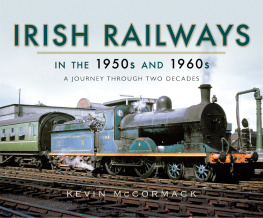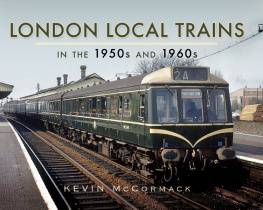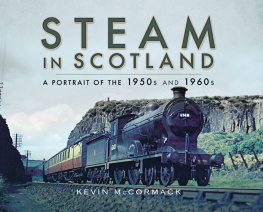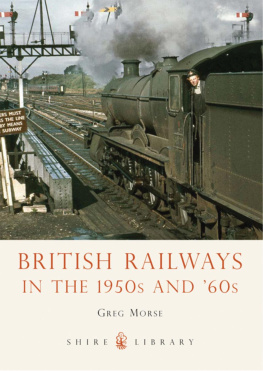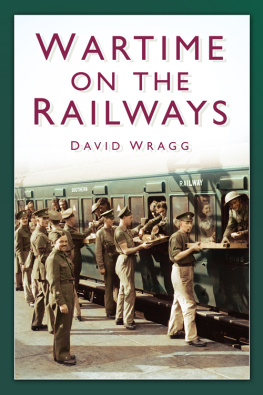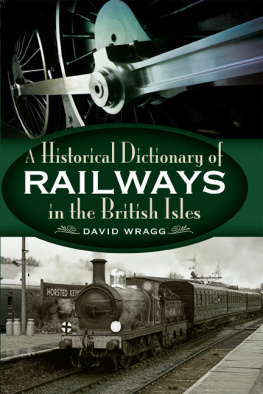McCormack Kevin - Britains Declining Secondary Railways through the 1960s
Here you can read online McCormack Kevin - Britains Declining Secondary Railways through the 1960s full text of the book (entire story) in english for free. Download pdf and epub, get meaning, cover and reviews about this ebook. year: 2016, publisher: Pen & Sword Books, genre: Non-fiction. Description of the work, (preface) as well as reviews are available. Best literature library LitArk.com created for fans of good reading and offers a wide selection of genres:
Romance novel
Science fiction
Adventure
Detective
Science
History
Home and family
Prose
Art
Politics
Computer
Non-fiction
Religion
Business
Children
Humor
Choose a favorite category and find really read worthwhile books. Enjoy immersion in the world of imagination, feel the emotions of the characters or learn something new for yourself, make an fascinating discovery.
- Book:Britains Declining Secondary Railways through the 1960s
- Author:
- Publisher:Pen & Sword Books
- Genre:
- Year:2016
- Rating:5 / 5
- Favourites:Add to favourites
- Your mark:
- 100
- 1
- 2
- 3
- 4
- 5
Britains Declining Secondary Railways through the 1960s: summary, description and annotation
We offer to read an annotation, description, summary or preface (depends on what the author of the book "Britains Declining Secondary Railways through the 1960s" wrote himself). If you haven't found the necessary information about the book — write in the comments, we will try to find it.
Britains Declining Secondary Railways through the 1960s — read online for free the complete book (whole text) full work
Below is the text of the book, divided by pages. System saving the place of the last page read, allows you to conveniently read the book "Britains Declining Secondary Railways through the 1960s" online for free, without having to search again every time where you left off. Put a bookmark, and you can go to the page where you finished reading at any time.
Font size:
Interval:
Bookmark:
First published in Great Britain in 2016 by
Pen & Sword Transport
An imprint of Pen & Sword Books Ltd
47 Church Street
Barnsley
South Yorkshire
S70 2AS
Copyright Pen & Sword Books Ltd 2016
ISBN: 978 1 47386 0 292
PDF ISBN: 978 1 47386 0 322
EPUB ISBN: 978 1 47386 0 315
PRC ISBN: 978 1 47386 0 308
The right of Kevin McCormack and Martin Jenkins to be identified as the author of this work has been asserted by him in accordance with the Copyright, Designs and Patents Act 1988. All rights reserved. No part of this publication may be reproduced or transmitted in any form or by any means, electronic or mechanical, including photocopy, recording or any information storage and retrieval system, without the prior written permission of the publisher, nor by way of trade or otherwise shall it be lent, re-sold, hired out or otherwise circulated without the publishers prior consent in any form of binding or cover other than that in which it is published and without a similar condition including this condition being imposed on the subsequent purchaser.
Typeset by Pen & Sword Books Ltd
Printed and bound by Imago Publishing Limited
Pen & Sword Books Ltd incorporates the imprints of Pen & Sword Archaeology, Atlas, Aviation, Battleground, Discovery, Family History, History, Maritime, Military, Naval, Politics, Railways, Select, Social History, Transport, True Crime, and Claymore Press, Frontline Books, Leo Cooper, Praetorian Press, Remember When, Seaforth Publishing and Wharncliffe.
For a complete list of Pen & Sword titles please contact
Pen & Sword Books Limited
47 Church Street, Barnsley, South Yorkshire, S70 2AS, England
E-mail:
Website: www.pen-and-sword.co.uk
Front cover: Brighton-based Ivatt 2-6-2T, No.41302 stands at Bramley & Wonersh station on a Guildford-Horsham working on 18 January 1964. The line, which was nineteen miles long, closed on 14 June 1965, just under four months short of its centenary. All the railway structures at Bramley, apart from the platforms, were quickly demolished but, to improve the Downs Link footpath and bridleway that now occupies the trackbed, some features have since been replicated including the up platform shelter (behind the signal box) and the level crossing gates. One of the reinstated enamel station nameboards had been used as a shelf in a Worthing greenhouse! A fragment of the main station building survives because it contains a Royal Mail post box.
Title page: A shaft of sunlight catches a trio of railway workers at Woodford Halse shed in Northamptonshire on 19 January 1963. The depot opened due to the construction of the London extension of the Great Central Railway and, combined with a marshalling yard and railway station (called Woodford and Hinton until 1948), turned a small village into a minor railway town (it has now returned to being a village). The shed closed to steam on 14 July 1965 and Great Central services in the area were withdrawn on 5 January 1966. Woodford Halse was primarily a freight shed, as evidenced by the locomotives in the background that are mainly Standards. However, the depot had a small allocation of engines for local passenger trains, notably the Woodford-Banbury shuttles latterly hauled by Fairburn 2-6-4Ts, the final such service operating on 13 June 1964.
Contents
PREFACE
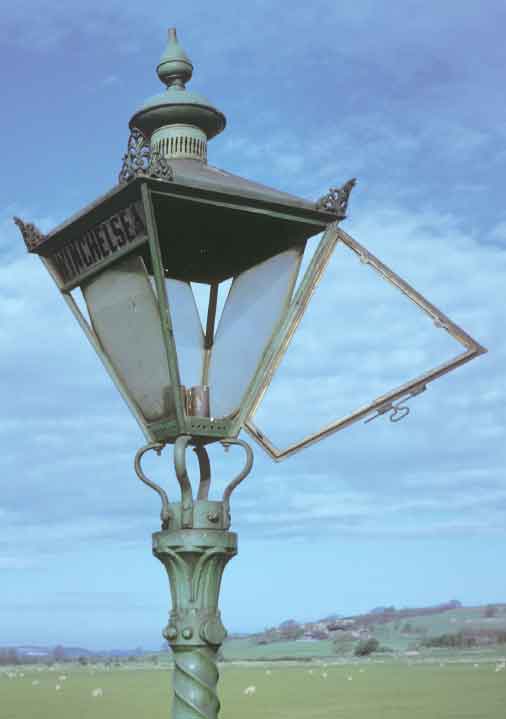
F ollowing a few early spasmodic closures, a decrepit railway emerged from another war, only to be nationalised in 1948. Line closures began in earnest starting with the hopelessly uneconomic, as car ownership took hold. By 1960 panic set in about rails viability with the urgent appointment of Dr Richard Beeching as the railways new emperor! His March 1963 report purely sped up what was already happening by listing a further 2,363 stations to close, 266 services to be withdrawn and the modification of 71 others. Beeching formalised an ongoing existing situation and I had to be one step in front of the Doctor by recording a fast disappearing age.
Flanged wheels guided by rails along a predetermined route had fascinated me from an early age. Visits to my grandparents in Winchelsea, East Sussex, introduced me to South Eastern H Class 0-4-4T locomotives on push/pull workings to Hastings, and afternoon tea in the Pullman on an electric to Lewes brought a touch of elegance. This was followed by steam via Sheffield Park, before the illustrious Miss Bessemer had saved the Bluebell Railways immediate closure by invoking an Act of Parliament, which was the highlight of the trip to East Grinstead, and then on to my Surrey home in Woldingham, giving another dose of steam.
From my Berkshire school, aged sixteen, I wrote to British Railways (BR) for possible employment. The letter was forwarded to the Western Region, though my actual home was on the Southern. So I joined the brown region at Paddington in 1960 rather than the green as a quirk of fate! Some senior staff still wore wing collars, most express trains were still painted chocolate and cream, so long as they were part of a named train, and varied stationmasters appearing for meetings delighted the Guvnors by wearing their Great Western pill box hats, albeit twelve years after nationalisation!
The District office saw me examining guards journals, which recorded each individual train journey. My eye caught interest in various steam-worked rural branch lines, which carried few, if any, passengers, and thats how it all started. I became mesmerised being chauffeured by steam through bucolic countryside with a guard and occasional passenger to keep me company in a world of forgotten ecstasy. How long could this bygone age of travel last? The camera clicked, and I soon had a wish list of lines to visit.
I took lodgings in West London where my landlady only took Great Western boys in the mistaken belief that GW boys were a cut above the rest! Nevertheless foreign inmates were carefully smuggled in! Alternate weekends were kicking out weekends, whereby one had to vacate the digs and lodge elsewhere. This was a marvellous incentive to go travelling. But with line closures speeding up under Beeching, it would have been pointless going in the wrong direction if one was going to get abysmal weather. People have commented that my pictures are always in the sun, but this was not luck. My strong rule was no sun, no picture, but I now regret taking few record shots. Time was against me. On a Friday morning I would listen to the countrywide weather outlook and then examine newspaper weather maps. After work I rechecked the radio weather forecast, by which time I had a good idea of what was happening. My final decision was taken minutes later, when one could actually speak to a person in the Met. Office about the possible location of blue skies. So off I went with my duffel bag and toothbrush, bought a ticket and took a chance often on the cushions overnight! Yes, it worked most of the time, but that was for Saturdays; but on Sundays steam and branch lines had usually vanished, which accounts for my having tramped every sleeper during every season in the Isle of Wight where BR maintained its daily steam museum service that seemed to go on forever!
Today, with more people travelling by train than ever, its easy to jest that todays privatised railway is costing the earth to run, but Dr Beeching did not forecast what might happen after 1970 in the middle of warring politicians, each of whom had starved the railway of any real investment. He might now be pleasantly surprised!
And what did I achieve 4,500 pictures later, taken over a span of ten years? I enjoyed the delights of a railway with its dedicated staff that was forever Britain, as steam trains and branch lines raced one another to vanish into oblivion.
Next pageFont size:
Interval:
Bookmark:
Similar books «Britains Declining Secondary Railways through the 1960s»
Look at similar books to Britains Declining Secondary Railways through the 1960s. We have selected literature similar in name and meaning in the hope of providing readers with more options to find new, interesting, not yet read works.
Discussion, reviews of the book Britains Declining Secondary Railways through the 1960s and just readers' own opinions. Leave your comments, write what you think about the work, its meaning or the main characters. Specify what exactly you liked and what you didn't like, and why you think so.


